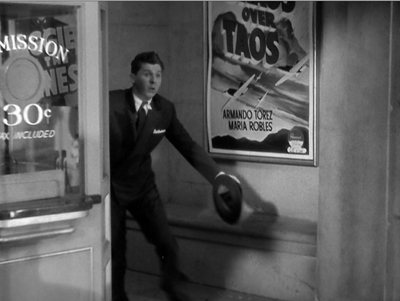Friday, May 31, 2013
David Bordwell on Hollywood in-jokes
These movies were made by youngish people who liked to have fun–sometimes at each other’s expense—and nothing is more fun than very esoteric in-jokes.
http://www.davidbordwell.net/blog/2013/05/27/on-the-more-or-less-plausible-sneakiness-of-one-preston-sturges/
Thursday, May 30, 2013
Oblivion, etc.
Remember when we started NotThatCritical and we meant to write briefly and quickly, with no pressure, because no one would be reading it? I think it was supposed to be: 1) no more than five hundred words per movie, and 2) write something every single day. We never really kept up with every single day part, but, you know, like Maude said, consistency is not really a human trait.
I saw Oblivion a couple weeks ago. Well, "saw" is probably overstating it. I was present for it, although I might have fallen asleep once or twice. I did gather that it was about killer drones (topical!), and I can report that during the time I was awake, Tom Cruise occupied probably about 85% of the screen time. Maybe 90%. I remember just one scene he was not in, where stoned-eyed Andrea Riseborough (who seems familiar but imdb reveals nothing I remember seeing her in) talked with Melissa Leo, but I think their conversation was mainly about the Tom Cruise character, so it does not pass the Bechdel Test.
Speaking of Tom Cruise, I read this Vulture article a month or so ago, and I just saw Lindy West's response to it, which is, as usual, pretty much spot on. The only thing I need to add is that when they say "analyzed the data" they really mean, "made up a bunch of data points and wrote down some ideas about them." Which is cool, that's mostly what we want from Vulture, right? But this actual data exists--you can get all of imdb's data, for money--so is someone doing an actual analysis of actual data? Because that could be really interesting.
This research on gender and the movies was released recently from the Annenberg School: http://annenberg.usc.edu/Faculty/Communication%20and%20Journalism/~/media/5DB47326757B416FBE2CB5E6F1B5CBE4.ashx
This paper interests me, but this sort of analysis is necessarily so very subjective, despite best efforts. See for instance, from page 11:
I feel pretty certain that are fewer leading women in the movies now than there used to be, and fewer of those leading women are tough. But I have no real idea of how to objectively assess that statement.
I saw Oblivion a couple weeks ago. Well, "saw" is probably overstating it. I was present for it, although I might have fallen asleep once or twice. I did gather that it was about killer drones (topical!), and I can report that during the time I was awake, Tom Cruise occupied probably about 85% of the screen time. Maybe 90%. I remember just one scene he was not in, where stoned-eyed Andrea Riseborough (who seems familiar but imdb reveals nothing I remember seeing her in) talked with Melissa Leo, but I think their conversation was mainly about the Tom Cruise character, so it does not pass the Bechdel Test.
Speaking of Tom Cruise, I read this Vulture article a month or so ago, and I just saw Lindy West's response to it, which is, as usual, pretty much spot on. The only thing I need to add is that when they say "analyzed the data" they really mean, "made up a bunch of data points and wrote down some ideas about them." Which is cool, that's mostly what we want from Vulture, right? But this actual data exists--you can get all of imdb's data, for money--so is someone doing an actual analysis of actual data? Because that could be really interesting.
This research on gender and the movies was released recently from the Annenberg School: http://annenberg.usc.edu/Faculty/Communication%20and%20Journalism/~/media/5DB47326757B416FBE2CB5E6F1B5CBE4.ashx
This paper interests me, but this sort of analysis is necessarily so very subjective, despite best efforts. See for instance, from page 11:
All characters were evaluated for attractiveness. This measure ascertained whether one or more characters in the plot verbally (e.g., “You are so hot!”) and/or nonverbally (e.g., cat call, whistling, gapping mouth) indicated the physical desirousness of another character. Self references did not count. Characters were coded as not attractive (i.e., no verbal or non verbal references), attractive (i.e., one reference), or very attractive (i.e., two or more references). These latter two levels were collapsed prior to analysis.Makes me a little dizzy, trying to think of ways to make an objective character attractiveness criteria.
I feel pretty certain that are fewer leading women in the movies now than there used to be, and fewer of those leading women are tough. But I have no real idea of how to objectively assess that statement.
 |
| Ripley: tough (wikimedia.org) |
 |
| Katniss: also tough (www.fanpop.com/) |
Subscribe to:
Posts (Atom)
